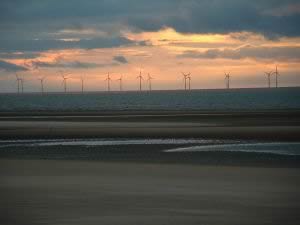| 11/12/07
The government made an announcement yesterday about a major
expansion of off shore wind power. Mark Newton wind farm expert
from Fisher German chartered surveyors responds.
© Sandi Baker
 |
“The reality is that the 7,000 target for off shore
wind turbines set by the government for 2020 is likely
to be unrealistic, considering that their short term target
of 10% electricity produced by renewable energy by 2010
is already falling far short.”
Mr Newton states, not only are the targets unrealistic
but when you consider the other following factors, the
off shore argument seriously starts to fall down;
- Currently,
an on shore wind farm costs about £1.3
million per mega watt (MW), while the off shore equivalent
costs £2.3 million per MW. This is because off
shore sites need to be built in water, into sand, with
substantial piling, concrete bases and a helipad can
be required. The grid connection is also expensive as
extra cabling is needed to bring the power back on shore.
- An
on shore wind turbine is typically 2.0 MW and off shore
turbines are currently 3 MW and the next generation will
be up to 5 MW
- Put these figures together and the off shore
wind turbines cost 75% more per MW compared to an on
shore turbine.
- Power companies have also been put off
building off shore wind farms as their maintenance is
much higher due to the corrosive effect of sea water
and physically getting to the structure to repair them,
particularly when the weather is bad.
- There is also a
supply issue, the cost of raw materials to build them
is going through the roof and in some cases, manufacturers
have pulled out of building off shore turbines as there
is a much easier market with on shore turbines. The number
of vessels required to build them are limited and all
booked up.
- The Green payment known as ROCs is currently
one ROC for on shore and one for off shore, this will
increase to one and a half ROCs for off shore wind farms
in 2009, which is a 50% increase in the payment, but
is unlikely to be enough compared to the additional cost
of building and running off shore wind farms.
The current position is that
there are 148 on shore wind farm sites and six off shore
sites making up 1.5% of the current source of renewable
electricity generated. By 2010, i.e in two years, to meet
the government’s 10% target,
electricity produced from wind farms will increase to 6%
(1.5% off shore and 4.5% on shore) i.e. twice as many turbines
will need to be built on shore as are currently built.
There are currently 1,900 turbines on shore and there will
need to be 3,600 turbines in total on shore to meet the
government’s targets. Considering sites can take
years in planning, these figures just do not add up and
their short term targets simply will not be reached. Mr
Newton can see big utility companies investing in these
off shore sites in the future but not the smaller companies.
The wind farm companies are therefore targeting on shore
sites where it is much easier to construct, but they are
being delayed in the planning process and even when they
do get planning it can take up to two years to get turbines
and there can often be several years delay in getting a
grid connection.
Fisher German is one of the leading firms representing
landowners and is the only firm recognised by the NFU in
England and Wales. They are currently dealing with wind
farm sites in England, Wales, Scotland, Ireland and Poland. “We
will initially assess all approaches you have free of charge
and normally a reputable wind farm company will pay a contribution
or all professional costs explains Mr Newton.
“We know the sector and the right companies to deal
with and have managed to negotiate some really attractive
deals for landowners, substantially increasing the terms
originally being offered. Mr Newton recently had a case
were a farmer had been offered a fixed rent and by altering
it so that he benefits to any increase in energy prices
he should earn an extra £2.5 million during the life
of the project. It is important any future projects are
signed this year, so that they can hope to get planning
permission and build the wind farms before part of the
on shore ROC payments go and they are less profitable for
the wind farm companies and the landowners.”
If you have been approached by a wind farm company then
our renewable energy team can advise you and your professional
costs are normally paid by any reputable wind farm companies.
For further information contact our renewable energy team:
Mark Newton on 01858 411215, George Simpson on 01785 273
995 and Stephen Rice on 01295 226 297.
 Telecom Operators Sharing Sites - Land and Property Owners Beware Telecom Operators Sharing Sites - Land and Property Owners Beware
 Natural
England Receives £2.9 Billion to Safeguard Environment Natural
England Receives £2.9 Billion to Safeguard Environment
 Brussels'
Demands on NVZs Defy Logic Brussels'
Demands on NVZs Defy Logic |


